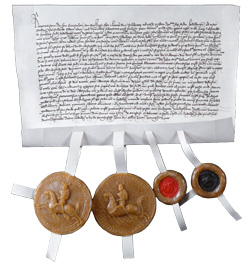In retrospect: 625
625 Years of Research and Teaching at the Ruperto Carola
 An exhibition of the Heidelberg University Library celebrating the 625th anniversary
An exhibition of the Heidelberg University Library celebrating the 625th anniversary
of Heidelberg University.
(http://ausstellung625uni2011.uni-hd.de)
Exhibition at the Heidelberg University Library
20 April - 4 December 2011
open daily 10:00 - 18:00
closed on public holidays
The exhibition “625 Years of Research and Teaching at the Ruperto Carola” gives insight into the history of science of Heidelberg University from its beginnings to the present.

Replica of the Corporate Charter
of Heidelberg University
(University Archive)
On October 23, 1385 the Roman Pope Urban VI. signed the foundation charter of the eldest university in present-day Germany. Even more than for the universities of Prage and Vienna - established before - the permission was passed to create a studium generalemodelled after the University of Paris (Sorbonne). From its beginnings the classical full University of Heidelberg included the Faculty of Arts and the “High Schools” of theology, jurisprudence and medicine. On October 18, 1386 a Solemn High Mass opened the University and the first lecture was held on the very next day.
The cause for the University's foundation was the Great Western Schism of 1378. In the course French cardinals elected an antipope in opposition to the Roman Pope, who was supported by the Palatinate. The German students were refused admittance to the Sorbonne and many scholars left Paris. So Marsilius of Inghen came to Heidelberg, too. He played a decisive role in the establishment of the University and he became its inaugural rector.
Close ties with the electoral court and the fruitful engagement with Humanism and the Reformation were operative in the initial flourishing of the University in the 15th and 16th centuries. Heidelberg, the capital of the Palatinate became an intellectual and cultural centre, in which scholars for the needs of the electoral court were trained, too. Since its foundation in 1386 the relations and interdependence between the University and the court were manifold. The exhibition points up these connections with manuscripts, incunabula and early prints.
The monarchs had direct influence on the University and particularly on the study contents relating to the statutes and reforms - binding regulations - made under their name. In 1452 Elector Palatine Frederic I. enacted a reform of the statutes, as a result the philosophical school of realism was allowed in addition to the up to now exclusively trained philosophical school of nominalism. A further amendment, that lasted for more than two hundred years, was implemented in 1558 during the reign of Elector Palatine Otto Henry. He already had introduced the Reformation into Palatinate in the year 1556. With assistance of Philipp Melanchthon he gave new statutes to the University and turned it from a secular scholastic institution to a modern reformed protestant university.

Palatinate Lion presenting the motto
of Heidelberg University: Semper apertus
(Julius Wilhelm Zincgref, 1619)
After an interim decline, the transfer to the state of Baden in the early 19th century gave the university a new lease of life, manifesting itself to this day in the academic success and the international reputation the university has achieved.
With reference to outstanding personalities like Robert Bunsen, Alfred Weber, Gustav Radbruch or Karl Hampe, the exhibition foregrounds Heidelberg's significant research achievements in the sciences and the humanities. The interdisciplinary exhibition represents all faculties and makes clear the diversity of the humanities and natural sciences trained at the Ruperto Carola.
With this exhibition the University Library also presents itself as a significant part of the University's history of science and scholarship. It supplies academic literature in printed and electronic form and is also active in research, engaging in national and international projects financed by third-party funding. Its rich historical collections contain not only medieval manuscripts but also the legacies of important Heidelberg scholars and scientists.
No catalogue will be published for the exhibition.
Contact
Universitätsbibliothek Heidelberg
 Dr. Maria Effinger
Dr. Maria Effinger
Tel. 06221-54-3561
 Dr. Karin Zimmermann
Dr. Karin Zimmermann
Tel. 06221-54-2592




